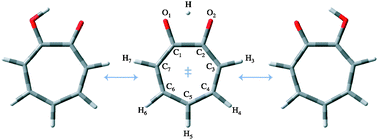Vibrational specificity of proton-transfer dynamics in ground-state tropolone
Abstract
The vibrational dependence of large-amplitude ![[X with combining tilde]](https://www.rsc.org/images/entities/i_char_0058_0303.gif) 1A1) of
1A1) of  to be extracted for 43 assigned vibrational features of a1 and
to be extracted for 43 assigned vibrational features of a1 and  reflect the state-specificity long attributed to the
reflect the state-specificity long attributed to the  ) found to exert the most significant influence on the efficacy of
) found to exert the most significant influence on the efficacy of

- This article is part of the themed collection: Chemical Dynamics of Large Amplitude Motion

 Please wait while we load your content...
Please wait while we load your content...